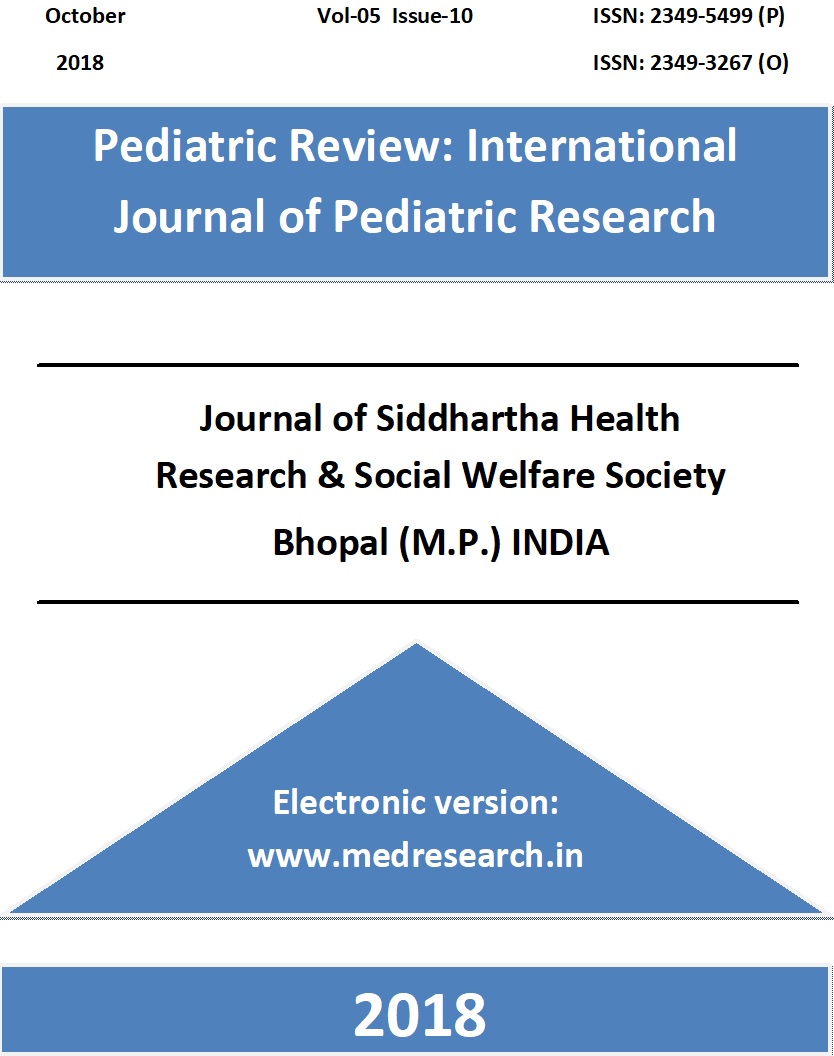Cerebro arteriovenous malformation presenting as recurrent epistaxis: a rare entity
Keywords:
AVM- Arteriovenous Malformation, Brain, Spine
Abstract
An arteriovenous malformation is an abnormal tangle of blood vessels in the brain or spine. Some AVM's have no specific symptoms and little or no signs to one's life or health, while others cause severe and devastating effects when they bleed. Treatment options range from conservative watching to aggressive surgery, depending on the type, symptoms and location of the AVM.
Downloads
Download data is not yet available.
References
1. Bambakidis NC, Sunshine JL, Faulhaber PF, Tarr RW, Selman WR, Ratcheson RA. Functional evaluation of arteriovenous malformations. Neurosurg Focus11(5):1–5, 2001.
2. Garretson HD: Intracranial arteriovenous malformations, in Wilkins RH, Rengachary SS (eds): Neurosurgery. New York, McGraw-Hill,1985, pp 2433–2442.
3. Moore KL: The Developing Human: Clinically Oriented Embryology.Philadelphia, Saunders, 1982, ed 3.
4. Heros RC: Arteriovenous malformations of the brain, in Ojemann RG, Heros RC, Crowell R (eds): Surgical Management of Cerebrovascular Disease. Baltimore, Williams & Wilkins, 1988, ed 2, pp 347– 413.
5. Tew, JM Jr, Lewis AI: Honored guest presentation: Management strategies for the treatment of intracranial arteriovenous malformations. Clin Neurosurg46:267–284, 2000.
6. Shenkar R, Elliott JP, Diener K, et al. Differential gene expression in human cerebrovascular malformations. Neurosurgery. 2003 Feb;52(2):465-77; discussion 477-8.[pubmed]
7. Hashimoto T, Lawton MT, Wen G, Young GY, Choly T Jr, Stewart CL, Dressman HK, Barbaro NM, Marchuk DA, Young WL: Genemicroarray analysis of human brain arteriovenous malformations. Neurosurgery54:410–425, 2004.
8. Pollock BE, Gorman DA, Coffey RJ: Patient outcome after arteriovenous malformation radiosurgical management: Results based on a 5-to 14- year follow-up study. Neurosurgery52:1291–1297, 2003.
9. Dasu MR, Barrow RE, Spies M, Herndon DN: Matrix metalloproteinase expression in cytokine stimulated human dermal fibroblasts. Burns29:527–531, 2003.
10. Ferroni P, Basili S, Martini F, Cardello CM, Ceci F, DiFranco M, Bertazzoni G, Gazzaniga PP, Alessandri, C: Serum metalloproteinase 9 levels in patients with coronary artery disease: A novel marker ofinflammation. J Investig Med51:295–300, 2003.
11. Leblanc R, Levesque M, Comair Y, Ethier R: Magnetic resonance imaging of cerebral arteriovenous malformations. Neurosurgery21:15–20, 1987.[pubmed]
12. Pouratian N, Cannestra AF, Bookheimer SY, et al. Variability of intraoperative electrocortical stimulation mapping parameters across and within individuals. J Neurosurg. 2004 Sep;101(3):458-66. DOI:10.3171/jns.2004.101.3.0458
13. Spetzler RF, Martin NA. A proposed grading system for arteriovenous malformations. J Neurosurg. 1986 Oct;65(4):476-83.DOI:10.3171/jns.1986.65.4.0476.[pubmed]
2. Garretson HD: Intracranial arteriovenous malformations, in Wilkins RH, Rengachary SS (eds): Neurosurgery. New York, McGraw-Hill,1985, pp 2433–2442.
3. Moore KL: The Developing Human: Clinically Oriented Embryology.Philadelphia, Saunders, 1982, ed 3.
4. Heros RC: Arteriovenous malformations of the brain, in Ojemann RG, Heros RC, Crowell R (eds): Surgical Management of Cerebrovascular Disease. Baltimore, Williams & Wilkins, 1988, ed 2, pp 347– 413.
5. Tew, JM Jr, Lewis AI: Honored guest presentation: Management strategies for the treatment of intracranial arteriovenous malformations. Clin Neurosurg46:267–284, 2000.
6. Shenkar R, Elliott JP, Diener K, et al. Differential gene expression in human cerebrovascular malformations. Neurosurgery. 2003 Feb;52(2):465-77; discussion 477-8.[pubmed]
7. Hashimoto T, Lawton MT, Wen G, Young GY, Choly T Jr, Stewart CL, Dressman HK, Barbaro NM, Marchuk DA, Young WL: Genemicroarray analysis of human brain arteriovenous malformations. Neurosurgery54:410–425, 2004.
8. Pollock BE, Gorman DA, Coffey RJ: Patient outcome after arteriovenous malformation radiosurgical management: Results based on a 5-to 14- year follow-up study. Neurosurgery52:1291–1297, 2003.
9. Dasu MR, Barrow RE, Spies M, Herndon DN: Matrix metalloproteinase expression in cytokine stimulated human dermal fibroblasts. Burns29:527–531, 2003.
10. Ferroni P, Basili S, Martini F, Cardello CM, Ceci F, DiFranco M, Bertazzoni G, Gazzaniga PP, Alessandri, C: Serum metalloproteinase 9 levels in patients with coronary artery disease: A novel marker ofinflammation. J Investig Med51:295–300, 2003.
11. Leblanc R, Levesque M, Comair Y, Ethier R: Magnetic resonance imaging of cerebral arteriovenous malformations. Neurosurgery21:15–20, 1987.[pubmed]
12. Pouratian N, Cannestra AF, Bookheimer SY, et al. Variability of intraoperative electrocortical stimulation mapping parameters across and within individuals. J Neurosurg. 2004 Sep;101(3):458-66. DOI:10.3171/jns.2004.101.3.0458
13. Spetzler RF, Martin NA. A proposed grading system for arteriovenous malformations. J Neurosurg. 1986 Oct;65(4):476-83.DOI:10.3171/jns.1986.65.4.0476.[pubmed]

CITATION
DOI: 10.17511/ijpr.2018.i10.01
Published: 2018-10-31
How to Cite
Dr.D. Manoj, Dr.Venkatasuryanarayana, & Dr. C.R. Banapurmath. (2018). Cerebro arteriovenous malformation presenting as recurrent epistaxis: a rare entity. Pediatric Review: International Journal of Pediatric Research, 5(10), 484-486. https://doi.org/10.17511/ijpr.2018.i10.01
Section
Case Report
Copyright (c) 2018 Author (s). Published by Siddharth Health Research and Social Welfare Society

This work is licensed under a Creative Commons Attribution 4.0 International License.


 OAI - Open Archives Initiative
OAI - Open Archives Initiative


